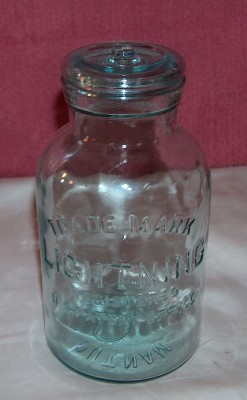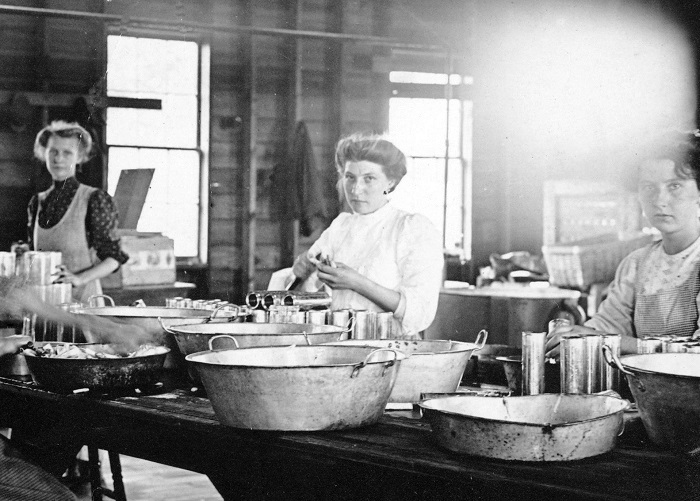Canning food in the modern world is easy. We have well-made jars, proven methods developed over a century and a half of trial and error, and the ability to consistently put up safe, nourishing and delicious food.
Even a century ago, canning was a well-established science, regardless of if you used Mason jars with zinc lids and rubber lids, or jars with glass lids and wire bails that locked down tight over a rubber ring. The end result was the same, even if the methods were quaint and old-fashioned today. But prior to our WWII-era metal bands and disposable lids, and prior to the old Lightning jars with wire bails or their competitors, and prior to the earliest Mason jars, there were other methods, and that’s what we are looking at today.
In 1858, John Landis Mason patented the basic screwtop canning jar. It used a zinc lid and a rubber band to provide an airtight seal, and with only minor modifications this method would remain unchanged until WWII. Mason revolutionized home canning with his simple invention, as it brought the reliability of consistently made canning jars, lids and rings into the public sphere for the first time. Prior to that, our ancestors had all manner of ways to put food up in glass and crockery jars.
Make ‘Off-The-Grid’ Super Foods Just Like Grandma Made! [2]
In 1810, Nicolas Appert, a French inventor, worked out the idea of hermetically sealing food in jars after cooking it. His methods involved placing food in jars, corking it, sealing the cork with wax, wrapping the jar in cloth and then boiling it. While science tells us now that the boiling of the jar essentially pasteurized it, Appert was unaware of the scientific reasons that ensured his method worked, only that it in fact worked. He was the first to put up food in glass jars, and he thought it was the exclusion of air that preserved the food (he was half right; the other half was in the boiling).
But prior to his efforts, people were still storing food in jars and crocks. The most common methods involved cooking food with a high sugar content or pickling them. In either case, the final product was placed in glass or crockery jars, and sealed in some form or another with glass, crockery, wooden or metal lids, wax, cloth or paper. Here we see the origins of canned food, but grossly lacking in the kind of processing that allows for safe, long-term storage. Such foods relied on their ingredients, being closed off from the air and stored in a cool dark place, and some of them are considered unsafe today.
 [3]The mid- to late-19th century was a boomtime for canning jars and canning technology. Before the Mason jar, we would see “wax sealers,” which used a glass lid and ring of hot wax to provide an airtight seal. This technology is echoed by modern homesteaders who may still use wax to seal jars of jams and jellies. It should be cautioned that wax-sealing of any sort, with or without a lid, was not always successful when it was in vogue, and should not be practiced now; it’s impossible to tell if you’ve gotten a good seal, and it’s easy to break the seal. I remember eating jams put up in wax-sealed jars by my grandmother, but I’d be hard-pressed to do it today.
[3]The mid- to late-19th century was a boomtime for canning jars and canning technology. Before the Mason jar, we would see “wax sealers,” which used a glass lid and ring of hot wax to provide an airtight seal. This technology is echoed by modern homesteaders who may still use wax to seal jars of jams and jellies. It should be cautioned that wax-sealing of any sort, with or without a lid, was not always successful when it was in vogue, and should not be practiced now; it’s impossible to tell if you’ve gotten a good seal, and it’s easy to break the seal. I remember eating jams put up in wax-sealed jars by my grandmother, but I’d be hard-pressed to do it today.
The World’s Healthiest Survival Food — And It Stores For YEARS and YEARS! [4]
Another common sort of jar was the “Lighting” or wire bail jar. Countless variations on this theme exist, ranging from the common sort we may know today to complex systems involving levers or even thumbscrews. All work on the same idea, though, of securely latching a glass lid over a rubber ring that has been sealed through boiling.
The harsh reality is until the 19th century, canning really didn’t exist, and food storage in jars, bottles and crocks was as much hit and miss, as accepting the fact you were stuck with heavily brined or sugared food. Modern concepts of sanitation did not exist, and stored foods were at a greater risk of loss through spoilage.
The current Mason jar, with its on-time use metal lid and reusable metal rings, represents the ultimate in home glass jar canning, and should be embraced with great vigor, due to the low cost, ease of use and proven sanitary track record. If you have older shoulder-seal jars like the old blue Ball jars, or wire bail seal jars, those are best left for decoration or dry storage, and given a gentle and loving retirement.
If you are looking to understand and practice home canning as done by our ancestors, then applying modern sanitary methods and storage, combined with well-made modern storage containers can be rewarding, but outside of an emergency, such methods should really only be practiced for entertainment. An exception could be argued in favor of certain pickling techniques, but those exceed the scope of this article.
Hundreds of companies made thousands of variations of canning jars through WWII, and many still survive today. They are a fascinating glimpse into a time in our nation’s history when self-reliance and sufficiency was an important part of many American’s lifestyles, and the ability to “put up” food for the winter could mean the difference between life and death.
Harness The Power Of Nature’s Most Remarkable Healer: Vinegar [5]
